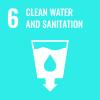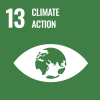Al Hadam, 17 November 2022 – Mohsin Faleh is a 30-year-old farmer in the southern Iraqi community of Al Hadam, Missan governorate. His face was weary as he surveyed the barren land that bears the scars of a complex water crisis that is expected to worsen.
“I don't remember the last time it rained; I think two years ago,” Mohsin commented in early October, on a day when temperatures hovered in the 40-degrees Celsius range.

Mohsin’s hand holding the dry soil which is affected by growing salination caused by the reduced flow of the Tigris and Euphrates. Photo: IOM 2022/Anjam Rasool
Iraq has two main sources of water – the Tigris and Euphrates rivers. The intake of water from both rivers is decreasing at an unprecedented rate, due to the construction of upstream dams and a prolonged drought.
Climate change, rising temperatures and the diversion of river water also mean that residents in Al Hadam struggle to access adequate water for use in their homes. This water scarcity is forcing some residents to uproot their lives and families.
Iman has six children and meeting her family’s water needs is difficult and expensive. “We are thinking of moving to the city because there is no water. We have to buy water,” said Iman, who was born and raised in Al Hadam.

Iman, mother of six children, is thinking of moving to the city because of the lack of water. Photo: IOM 2022/Anjam Rasool
Mohsin recalled that rainfall was predictable during his childhood, with rain arriving every year during the autumn season. The young farmer has observed dramatic changes to the climate, the soil and the water resources surrounding his community over the last few years.
Drought conditions are exacerbated not only by the decreased water levels in sub-canal systems near Al Hadam, but by their high saline content, making farming nearly impossible.

Children from Al Hadam’s community standing near the sub-canal from which water is sourced for treatment, filtration and delivery to families in two Al Hadam villages. Photo: IOM 2022/Anjam Rasool
Dwindling fresh water enables the salty tidewater of the Persian Gulf to seep into the Tigris and Euphrates, which feed sub-canals like in Al Hadam. The high salt content then depletes the parched farmland even more. Even the arrival of autumn rains may not be enough for the cultivation of farmland to sustain the region’s agricultural livelihoods.
Back in 2007, a water pumping station was installed to increase water flow in the area but quickly fell into disrepair and was eventually ransacked for mechanical parts, leaving the community without reliable water access.
In 2022, IOM Iraq worked with a local company to restore the water pump for use. The pump now draws water from a nearby sub-canal, where it is treated and distributed to families in two of Al Hadam’s villages for household use.

The rehabilitated Al Adlaa water station, which now serves 40-50 families in two of Al Hadam’s villages. Photo: IOM 2022/Anjam Rasool
While the installation of the pump provides some relief to the community, the scale of water needs in the area is outsized. Displacement of families is a reality in the community’s 13 villages, as water scarcity relentlessly takes its toll on agriculture and farming – the main source of income in Missan.
IOM Iraq provided Mohsin, and 79 other farmers from the community, with Individual Livelihood Assistance (ILA) in the form of a cash grant that he has used to buy farming tools and supplies in anticipation of the rainy season.
Ongoing interventions are needed at the governorate and national levels to harness existing resources and find adequate solutions for families in hard-hit areas like Al Hadam.
###
The ILA project and water pump restoration in Al Hadam were made possible with support from the US Department of State, Bureau of Population, Refugees and Migration (PRM).



